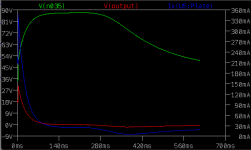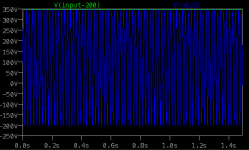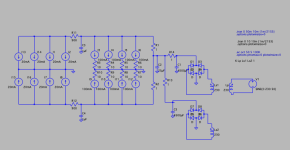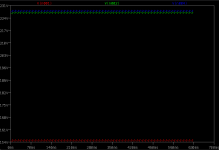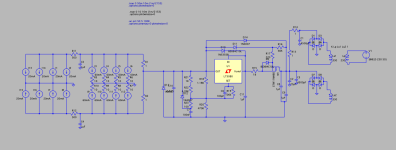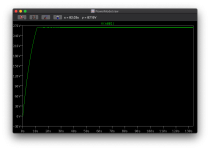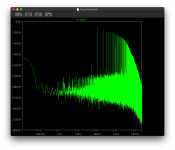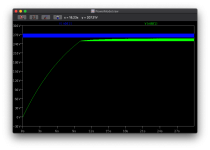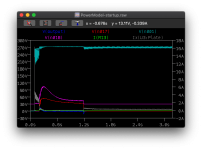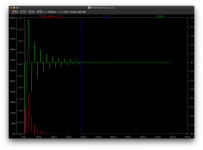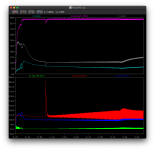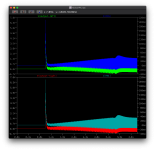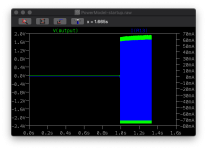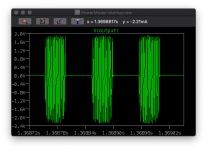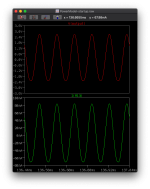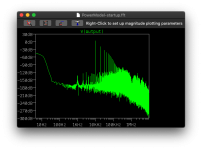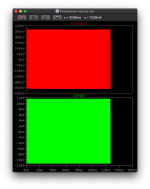So.. from the same run.. let's look at current. Although the final signal currents and voltages are not configured this looks promising as the same concept is valid:
Internal currents across the valves.
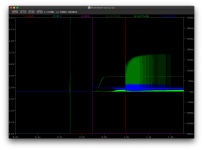
You can see the switching lines for the different startup stages - there is a big 3.16V peak-to-peak sine wave on the input from the start.
* not shown is the 0.2 mains trigger to bypass shown above.
* 0.5s (cyan) = B+ start
* 0.7s (pink) = clamp switches off, the blue pre-section tube current and green output stage current raise to idle current (operating class A bias always has current flowing through the device - this is what makes the class A 'hot'). You can also see a slight movement in the blue as the negative feedback returning to the input section starts to cause it react.
* 1.0s (red) = headphone mute switches off what which point you can see the green output currents rise as it pulls & pushes current through the headphone. Also the input section current (blue) causes changes to occur as the output section starts driving the headphones.
Note that there's no 1A spikes..
Now let's see what the headphone current overlaid on to that (grey):
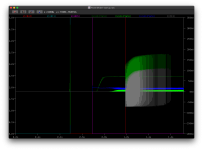
No big current spikes

And let's have a look at the voltages.
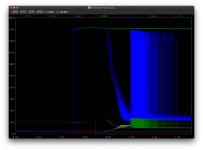
Not sure this is quite as rosy..
* switch signals are the small 5V signals at the bottom.
* 0.5s B+ start, the green B+ rectified voltage goes to 270V which is correct. The blue which is the valve anode voltage initially starts perfect but then takes a nose dive followed by spiking between the cathode and intended anode voltage.
* 0.7s the bias clamp switches off and as the currents start flowing the matt green (output cathodes) and grey lines (input cathodes) start up.
* 1.0s the headphone mute disables and the amp appears initially stable for about 100ms.. before the B+ issues starts to cause impact.
So what does the headphone see?
In gold overlaid is the voltage that the headphones now see.
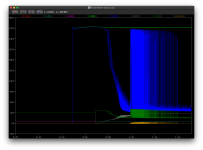
Phew.. so although there's a problem - the headphones simply see no voltage spikes output normal working voltages.
Now.. what causes that problem - I suspect is the current limiter not being right which I've added at the top of the output valves to prevent a unhindered flow from the headphones to the B+ line in case of shorts or tube failure.
Looking at the output CCS, the current limiter and the output capacitor you can piece together what is happening:
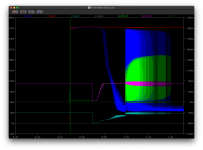
* 0.5 B+ start - the B+ rail in red is steady.
* 0.7 the cathode clamp stops and the tubes are free,
1. you can see the lower CCS (pink) takes a hit and then provides 75mA sustained idle current.
2. you can see the blue anode voltage of the output tube then takes a complete dive.
Voltage = current * resistance.
So this looks like the current is now flowing through a different path and so incurs a different resistance. Given the cathode voltage (cyan) increases this is likely that it's pilling through
The current through the valve at this stage begins to climb, as it conducts. As the valve is less resistance we have our change in resistance.
The valve (actually this would be all three but I only have on in there) is now conducting all the 75mA idle current that is being limited by the lower CCS. This is normal (the normal idle current per valve would actually be 25mA).
Unlike an anode follower.. we're not following the voltage to to make the sound for the headphones.. we're using the cathode and it's current flow however we need a voltage across the tube for it to remain stable.
So what is causing it? Well V=IR the relationship sort of points to current.. or the controlling of the current. The lower CCS is fine, it's working and doing it's job. The upper CCS is limiting the current flow. However when the resistance falls then there is no extra current to compensate and the voltage drops. Although the output cap has energy to provide current, there's no outlet.. or resistance to cause it.
* 1.0s headphone mute disable
Now the system finds the resistance on the other side of the output cap changes from 10,000 ohms to 32.. although DC current doesn't flow, AC currents do.. thus you see a increase in the currents flowing through which causes an oscillation in the blue valve anode response.. that finally dies out at about 1.4 seconds.
The current through the valve anode (green) shows this..
I think part of this is down to not having the final signals voltages (ie grid voltages setup) thus larger currents are allowed but.. this also points to the fact, at the moment, the use of an upper CCS rather than perhaps a more traditional current limiter is causing an issue.
V=IR.
If less current flows through the valve we see less anode voltage.
If the valve conducts more (or paths present a lower resistance) then resistance drops. Then we see less anode voltage.
An upper CCS that is being triggered into limiting (and assumes the model is not magically creating current) would cause (a) higher resistance and (b) less current.. the tube sat behind it.. would then see a limit to the current, it's own resistance would drop and the voltage would drop.
So it's good that it's seen it has a positive safety effect.. but I need to design it so it only starts infringing when it needs to limit. The current input signal is a 3.16V peak signal (I said peak-to-peak earlier but that's incorrect) which is +20% dbV for consumer line-in. This is deliberate to ensure the amp has headroom to cope with big transients such as cymbals or electronica without compressing the signal. A normal signal on a consumer system should be 0.447V peak.


